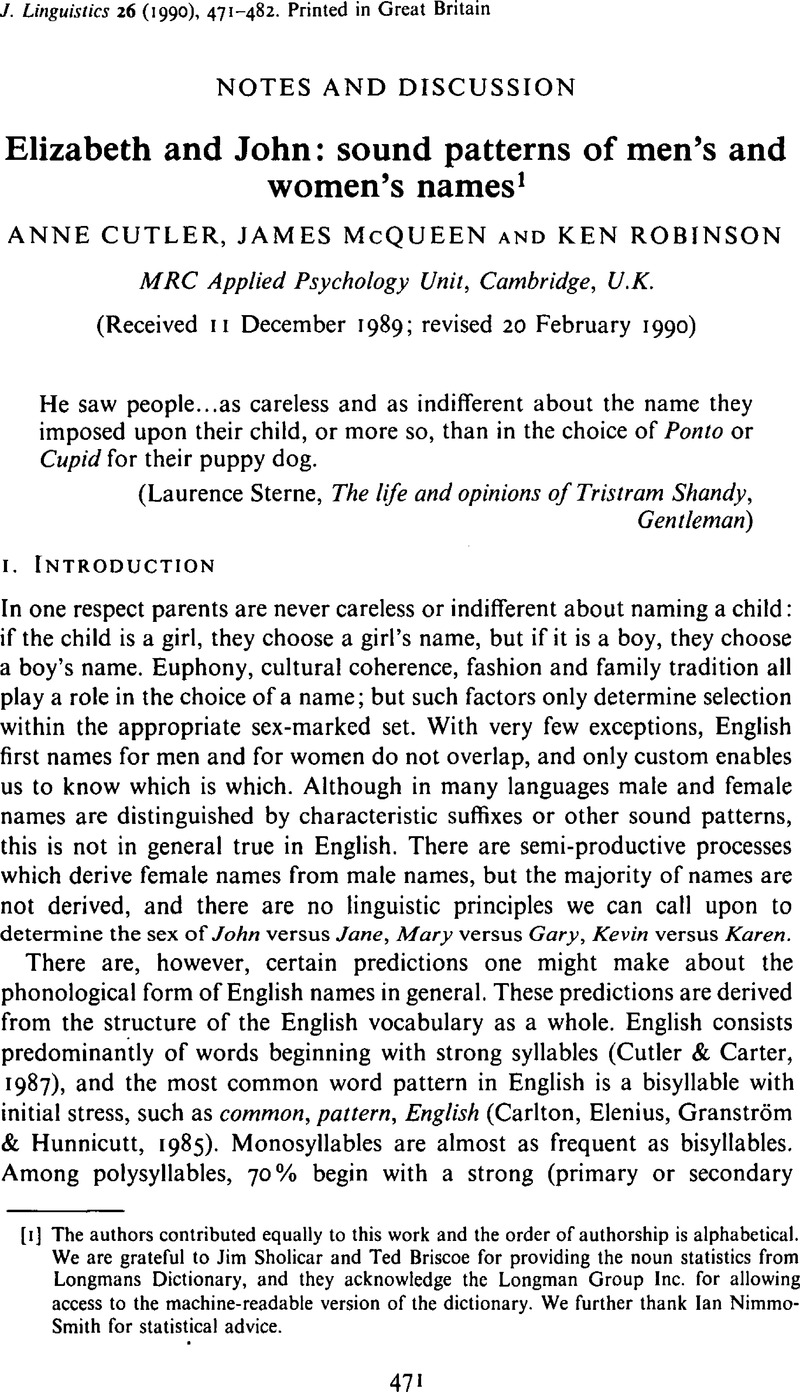Crossref Citations
This article has been cited by the following publications. This list is generated based on data provided by Crossref.
Van Lancker, Diana
1991.
Personal relevance and the human right hemisphere.
Brain and Cognition,
Vol. 17,
Issue. 1,
p.
64.
de Klerk, Vivian
and
Bosch, Barbara
1997.
Nicknaming among Xhosa-speaking children and adolescents.
South African Journal of African Languages,
Vol. 17,
Issue. 3,
p.
95.
de Klerk, V.
and
Bosch, B.
1997.
The sound patterns of English nicknames.
Language Sciences,
Vol. 19,
Issue. 4,
p.
289.
Jusczyk, Peter W.
1998.
Constraining the search for structure in the input.
Lingua,
Vol. 106,
Issue. 1-4,
p.
197.
Coates, Richard
1999.
The Cambridge History of the English Language.
p.
330.
Jusczyk, Peter W.
Houston, Derek M.
and
Newsome, Mary
1999.
The Beginnings of Word Segmentation in English-Learning Infants.
Cognitive Psychology,
Vol. 39,
Issue. 3-4,
p.
159.
BARRY, HERBERT
2000.
THREE LAST LETTERS IDENTIFY MOST FEMALE FIRST NAMES.
Psychological Reports,
Vol. 87,
Issue. 5,
p.
48.
Barry, Herbert
and
Harper, Aylene S.
2000.
Three Last Letters Identify Most Female First Names.
Psychological Reports,
Vol. 87,
Issue. 1,
p.
48.
Miall, David S.
2001.
Sounds of contrast: an empirical approach to phonemic iconicity.
Poetics,
Vol. 29,
Issue. 1,
p.
55.
Johnson, Elizabeth K.
and
Jusczyk, Peter W.
2001.
Word Segmentation by 8-Month-Olds: When Speech Cues Count More Than Statistics.
Journal of Memory and Language,
Vol. 44,
Issue. 4,
p.
548.
Barry, Herbert
and
Harper, Aylene S.
2001.
Research on First Names by Two Psychologists.
Names,
Vol. 49,
Issue. 4,
p.
259.
Thiessen, Erik D.
and
Saffran, Jenny R.
2003.
When cues collide: Use of stress and statistical cues to word boundaries by 7- to 9-month-old infants..
Developmental Psychology,
Vol. 39,
Issue. 4,
p.
706.
Mirkovic, Jelena
MacDonald, Maryellen C.
and
Seidenberg, Mark S.
2005.
Where does gender come from? Evidence from a complex inflectional system.
Language and Cognitive Processes,
Vol. 20,
Issue. 1-2,
p.
139.
Wright, Saundra K.
2006.
Phonological Cues Influence Sex Decisions about Novel Names.
Psychological Reports,
Vol. 99,
Issue. 2,
p.
315.
WRIGHT, SAUNDRA K.
2006.
PHONOLOGICAL CUES INFLUENCE SEX DECISIONS ABOUT NOVEL NAMES.
Psychological Reports,
Vol. 99,
Issue. 6,
p.
315.
Kennedy, Robert
and
Zamuner, Tania
2006.
NICKNAMES AND THE LEXICON OF SPORTS.
American Speech,
Vol. 81,
Issue. 4,
p.
387.
Abel, Ernest L.
and
Kruger, Michael L.
2007.
Gender Related Naming Practices: Similarities and Differences Between People and their Dogs.
Sex Roles,
Vol. 57,
Issue. 1-2,
p.
15.
Lee, Ming-Wei
and
Gibbons, Julie
2007.
Rhythmic alternation and the optional complementiser in English: New evidence of phonological influence on grammatical encoding.
Cognition,
Vol. 105,
Issue. 2,
p.
446.
Coffey, B.
and
McLaughlin, P. A.
2009.
Do Masculine Names Help Female Lawyers Become Judges? Evidence from South Carolina.
American Law and Economics Review,
Vol. 11,
Issue. 1,
p.
112.
BROERSMA, MIRJAM
2009.
Triggered codeswitching between cognate languages.
Bilingualism: Language and Cognition,
Vol. 12,
Issue. 4,
p.
447.





